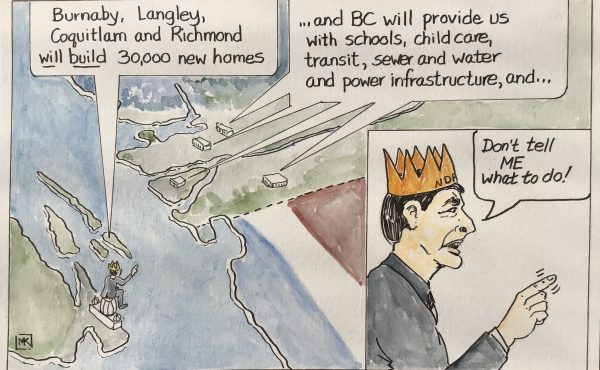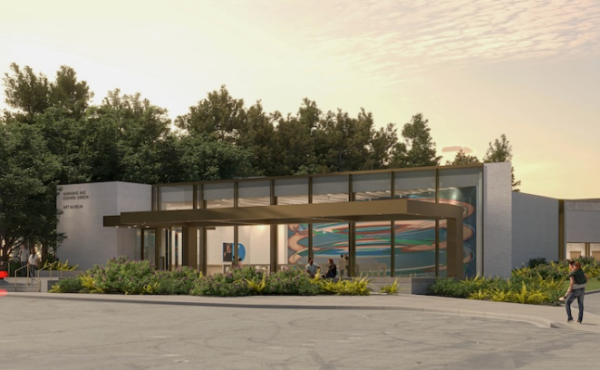
Text and photos by Sean Ruthen, re:place magazine
As a musician studying architecture at UBC over a decade ago, I was not overly surprised at that time to discover that singer-songwriter Paul Simon was also a musician with an architectural background. Simon was 18 years old when Frank Lloyd Wright passed away in 1959, an event which compelled him to write the song ‘Goodbye Frank Lloyd Wright’ with his musical partner Art Garfunkle. And so similarly, with the new president of the Architectural Institute of BC, Pierre Gallant, having written a poignant summation of Mr. Erickson’s career on his passing, as well as numerous other pieces in the national papers, including a piece by City of Vancouver’s head of planning Brent Toderian and an editorial in the latest Vancouver Magazine, I too would like to write a song on the passing of one of the profession’s great master builders.
Having gone to school in the Lower Mainland, it goes without saying that his influence on me has been immense, and I was privileged to have been able to share his company on one or two occasions. My first memory of him (tragically) was while I was attending TUNS in Halifax, whereupon my first-year studio and I were shocked to hear of his office having filed for bankruptcy protection. Despite my having grown up in the Canadian Maritime provinces, his Robson Square was known to me there, though it would be six more years until I would visit it in person (along with the Museum of Anthropology). That event in 1991 was so devastating to me that it made me question whether I wanted to enter the profession of architecture, and I left Halifax and pursued other studies for the next five years.
Since that time, I had the privilege of being given a guided tour of the Museum of Anthropology by Mr. Erickson himself, along with a group of visiting architectural scholars from MIT. Some years later, I was among many others gathered at the AIBC Architecture Gallery to celebrate the successful restoration of his Filberg House, along with the exhibition of Simon Scott’s photography of the same. And so from that time when I first arrived here to just a few weeks ago, Mr. Erickson had represented to me the embodiment of the successful architect. Not just locally, but nationally and internationally, his influence has been far reaching, and his legacy will continue inspire us all for years to come.

As noted, much has been said already, so I will attempt to fill in some gaps in what has been said. One anecdote about Mr. Erickson, found quite surreptitiously while researching for a local walking tour, is how he was architectural consultant for the locally shot Hollywood film ‘Intersection’. Regardless of the lackluster performance at the box office, the main character in the movie plays an architect whose project that opens during the course of the movie just happens to be the Museum of Anthropology. What is less known perhaps is that the moviemakers, probably on the advice of their architectural consultant, digitally inserted the reflecting pond in front of the Great Hall for one split-second scene; an insignificant moment for most movie-goers, but a monumental one to be sure for Mr. Erickson.
This was of course a few years before the APEC summit, when the powers-that-be would actually fill the pool in and drain it all in the space of a few days. During my most recent visit, forest fires up north had turned the sun bright orange as it set, and with its western exposure, Mr. Erickson’s marvelous western elevation lit up, despite the absence of the reflecting pool. I have visited the building and site countless times, and I hope that the University will take responsibility for this architectural masterpiece in their possession and allow the things that need to happen to happen, so that the pool at long last may be filled.
Another fantastic experience of Mr. Erickson’s architecture is his Canadian Embassy in Washington, DC. With the endless blocks of ‘white city’ architecture and other miscellaneous iconography of the famous capital city, seeing Mr.Erickson’s work on the Mall beside the Capitol building and I.M.Pei’s treasured National Gallery building is most profound. Like his Roy Thomson Hall in Toronto, they both have their critics, but both remain some of his most notable work outside the Lower Mainland, including the more recent Tacoma Glass Museum, realized with longtime collaborator Nick Milkovich. If more of his visions for the Middle East had been realized, like these three projects they would most certainly be heralded today as early milestones in those countries more recent intensifications.

Without doubt, the body of work representing his career in the Lower Mainland is immense. A recent monograph, with an accompanying exhibtion at the VAG, was a presentation of his most familiar projects. Trevor Boddy had the right mind to include Mr. Erickson in his touring show on Vancouverism (which I was fortunate to have seen it in London last summer before it moved on to Paris). Arthur was the obvious choice in the show, as his influence in Vancouver’s growth in the last half century is indisputable. His 1950’s sketches of the West End are a testament to his vision of the Vancouver peninsula, imagining a city of 10 million inhabitants similar to Le Corbusier’s vision of Paris for 3 million.
This was perhaps the most fertile time for our young city’s imagination, and Mr. Erickson was to have a hand in it, being at the right place at the right time. As discussed in Helena Grdadolnik’s Canadian Architect article ‘King Arthur’, it was a golden age when architects and city planners were aligned to a common goal. The waterfront around False Creek was still an eyesore, Yaletown and Gastown were just gleams in some developer’s eye, and Arthur was to have the most modern vision for the future. While current head of city planning Brent Toderian admits to having difficulty with the early tenets of modernism Mr. Erickson represented, it goes without saying that the Law Courts and Robson Square was one of the best things that could’ve happened to the downtown core at the time, especially when set against the 55-storey tower originally planned for the site. How Robson Square’s new incarnation will serve the public remains to be seen, but it is telling of Arthur’s legacy that his and Cornelia Oberlander’s urban park will be a part of the 2010 Winter Olympics.
Along with his Museum of Anthropology and Law Courts, Mr. Erickson leaves us five other masterpieces in and around Vancouver. The former MacMillan Bloedel building on Georgia Street, perhaps a tad brutal for some, is a poetic recasting of the Doric order, rendered in his favourite urban material, i.e. concrete. Next is his Simon Fraser University campus, a continuation of his modern rendering of classical architecture, a sequence of spatial experiences reminiscent of the Acropolis. Built at the same time as Ron Thom’s Trent University, it was a watershed moment in the history of our nation’s ambitions to build new universities across the Canadian landscape, and fitting that Arthur should be a part of it. More recently, his Waterfall Building with Nick Milkovich opened to great enthusiasm as an example of what an urban in-fill project adjacent to Granville Island could be.

The other two works of his are a bit more personal to me and perhaps less known. The first is his Evergreen Building, which is almost complete in its long-needed restoration. With its terraces stepping out towards Stanley Park and the north shore mountains, it is a genius solution for an otherwise banal ten-storey office building, and as Helena mentioned, would be unthinkable in today’s now crazy (though recently cooled) office real-estate environment. Some will also have heard how the building narrowly escaped the wrecking ball, only thanks to the concerns of local architects and investors. And with the adjunct of Henriquez Partners’ Coal Harbour Community Centre being built kitty-corner to the office building in 1999, the views from the terraces remain free of obstruction.
The second personal and less known project of Mr. Erickson’s is his garden behind the Faculty Club at UBC. Built around the same time as the Museum of Anthropology, it is an example of how architecture can create sheer poetry when combined with careful attention to landscape, even at the most intimate of scales. Essentially a small dance hall (now classroom) and garden, then director of SOA Christopher MacDonald took our first-year studio to the facility, which at the time had fallen into disrepair. Since reconstituted and returned to the Faculty Club, it is one of Arthur’s breathtaking treasures that would’ve otherwise gone unknown to me. With clerestory lighting along the small hall’s soffits, it boasts a reflecting pool on the structure’s roof, probably one of the first of its kind, and shortly thereafter to be echoed in the waterfalls of his Law Court Building.

As mentioned, Arthur’s popularity with the public was considerable, and became first apparent to me when I attempted to hear him speak (along with the rest of my graduate class) at Robson Square and couldn’t get in because it was filled to capacity. More recently, while at an Olympics volunteer seminar, I saw that Mr. Erickson was featured as a local artist alongside Sarah McClachlan and Douglas Coupland, all representative of the distinct culture that has blossomed in the Lower Mainland. For a summer a few years back, colourful banners depicting four of his key projects lined the Granville Street Bridge, and his enthusiasm for three new Vancouver projects kept him in the public eye right up to the end. He was an educator and mentor of many, and will forever hold a place in the hearts of all who encountered him and his work.
In the recent documentary film on the architect ‘The Life and Times of Arthur Erickson’, the historians discuss how Arthur turned down an offer to work for Frank Lloyd Wright, instead opting to travel around Europe. And how during his time stationed overseas in WWII, he was exposed to the serenity of Eastern architecture. These anthems of independence and composure are echoed in his early houses, those first great exclamations of Westcoast modernism, which remain the most honest and direct expression of his spirit, and for which he will be remembered long after the sheen is off the new Erickson tower, or when the new Olympic Village in False Creek is at long last paid for.
In the end, he was the alchemist who turned concrete into marble.
Thank you Arthur for being a part of our lives, and know that your spirit lives on in your buildings.
By Sean Ruthen
Sean Ruthen is a contributing editor for re:place magazine. Born in Halifax, he has also lived in New Brunswick, Ontario, and Alberta. He currently lives in Vancouver.


